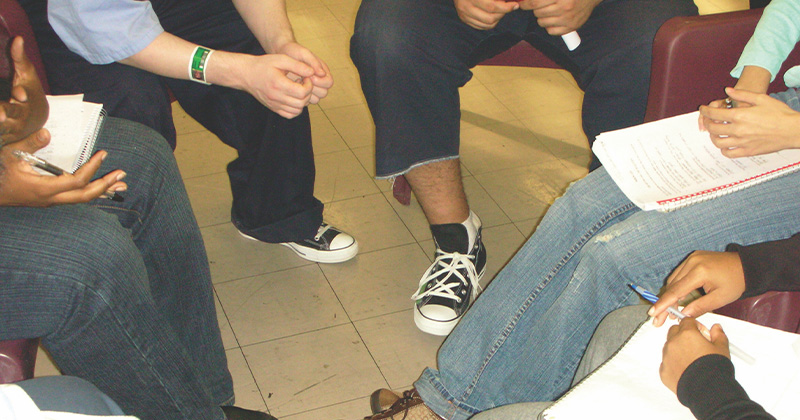


UD class behind prison walls
Photo courtesy of Inside-Out Prison Exchange Program® February 20, 2025
‘Inside-Out’ facilitates dialogue despite differences
No hoodies or sweatpants. No jewelry except wedding or engagement rings and small stud earrings. No phones. No pencils or blue pens — only black ink pens.
The list of dos and don’ts to enter the classroom where University of Delaware instructor Tanya Whittle teaches “Drugs in the Criminal Justice System” is long and inflexible, but also understandable, given that this innovative class doesn’t take place on campus, but rather behind bars.
Half of the students are men who are incarcerated, and the other half are UD undergraduates. Whittle teaches the class at Howard R. Young Correctional Institute in Wilmington as part of the Inside-Out Prison Exchange Program®, an international program hosted at UD by the Department of Sociology and Criminal Justice. Classes also are taught at Baylor Correctional Institute, a women’s facility.
Inside-Out was established at Temple University in 1997 to bring traditional college students and people who are incarcerated together in semester-long courses to explore and learn about issues of crime and justice from behind prison walls, based on the hypothesis that incarcerated and non-incarcerated students might mutually benefit from studying together as peers. Inside-Out has been taught at UD since 2005 and is now at more than 150 institutions worldwide.
“The class was nothing short of transformational,” said Olivia Ferrier, a senior double majoring in political science and public policy, who took the class last year and was a teaching assistant to Whittle last semester.
“I had a really specific view of incarcerated people before I went into this class,” said Ferrier, who plans to go to law school. “Now I don't think ‘good’ or ‘bad’ are able to fully encompass and represent all of the nuances that should be afforded to every single person.”
Life-changing experiences
Whittle’s class focuses on the drugs-crime nexus and the criminal justice system response. It examines issues of victimization, international policy and policy responses including drug treatment, harm reduction and restorative justice. All students are expected to read a variety of texts and write several papers.
The class is as rigorous as any Whittle teaches on UD’s Newark campus, but she makes accommodations for the unique classroom environment. She incorporates ice breaker activities to break down barriers and build rapport. Each week the students discuss issues in small groups and, in the final month, work together on a class project.
“The inside students help everybody contextualize the issues that we’re talking about because they’ve lived them,” Ferrier said. “Many of the people in these classes are there on drug offenses or they’re on violent charges and can speak directly to a lot of the things that we are reading about.”
“This class gives students an opportunity for academic enrichment and interpersonal connections they never would have made,” said Jim Berman, who served as a teaching assistant last semester after taking the class as an inside student.
For many, the class is nothing less than life-changing, helping outside students discern their career interests and providing inside students with pathways to successful reentry into the community.
Barbara White is one such student. White was taught by Chrysanthi Leon, a UD professor of sociology and criminal justice, and later became Leon’s teaching assistant for several semesters.
White was released from Baylor last February and is living in transitional housing with plans to move into her own apartment soon. Before she was incarcerated, she earned bachelor’s and master’s degrees and worked as a registered nurse.
“Inside Out gave me the opportunity to continue to acquire knowledge and provided me with a semblance of normalcy,” she said. “Coming into the classroom, prison disappeared. I was meeting with fresh minds. Not only the outside students, but I also got a different take on my peers because we were in a different atmosphere.”
Today White is on the board of PIRCOD – Partners in Reentry Coalition of Delaware, a consortium of community and state organizations supporting individuals coming out of incarceration. She also works part-time at Goodwill as a job coach.
More than 70% of people released from prison in Delaware are rearrested within three years, according to the Delaware Criminal Justice Council. White doesn’t plan to become one of those statistics and credits Inside Out with helping her — and numerous other individuals — be better prepared for reentry into the community.
“Inside Out is the ‘what's next,’” White said. “It’s the next door to open. You can put it on your résumé and even though you have a gap, you can point to it and say, ‘Well, I was in college. This is what I did.’”
Effective and evidence-based
Successful inside alumni like White are not uncommon. Leon and former criminal justice graduate student Graciela Perez conducted research examining why the program works.
“The Inside-Out program is consistently described as life-changing and transformative, but there wasn’t a lot of scholarship that documented this impact and how it manifests in the course,” Leon said. “Our study, conducted over three years, looked to provide a nuanced understanding of the experiences of students enrolled in the program.”
This research, published in the 2020 article “Beyond Bars” in the Journal of Correctional Education, indicated that initial criminal stigma perceptions held by outside students of inside students were replaced by bonds that broke deeply held beliefs of the criminal justice system and those caught in it.
Ferrier would agree.
“I can do the reading for class, and highlight and annotate, and pull out important details from it,” noted Ferrier, “but I’m never going to understand it in the way that someone who has lived that experience will.”
Contact Us
Have a UDaily story idea?
Contact us at ocm@udel.edu
Members of the press
Contact us at 302-831-NEWS or visit the Media Relations website

